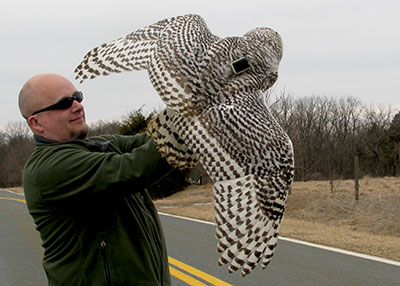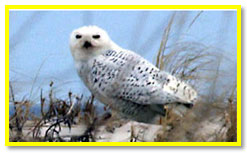Snowy Owl
(Bubo scandiacus)
Description:
Snowy owls are unmistakable, large, white owls. Adult males are almost fully white in appearance and occasionally sport a few dark marks. In contrast, females and juveniles tend to have dark scalloping and spotting. Younger birds are more heavily barred, adults less barred. All snowy owls have striking yellow eyes and a dark bill. Their coloration, thick plumage, and heavily feathered talons make them well-adjusted for life in the Arctic. Snowy owls are the largest (by weight) North American owl, often weighing between 3-6 pounds. Males, on average, are smaller than females.
Range
Snowy owls nest in the Arctic tundra within the northernmost areas of Alaska, Canada and Eurasia. In the winter, snowy owls will often migrate through Canada and northern Eurasia with occasional irruptions occurring further south. Snowy owls are rare winter visitors to Maryland.
Monocacy, a female snowy owl banded in Maryland in 2014 by Kerry Wixted
Habitat:
Typical snowy owl habitat includes tundra, meadows, marshes, and dunes. In Maryland, Assateague Island is a popular snowy owl winter site.
Behavior:
Other than during the long Arctic summer Snowy owls are like all other owls. During the summer they actively hunt day and night to feed their hungry brood. Outside of the Arctic summer they do most of their hunting at night. Snowy owls are highly nomadic traveling long distances in search of the high vole densities that they need for successful breeding. Distances of 500-1,000 miles often separate consecutive locations where they breed. Many adult Snowy Owls spend their winter in the total darkness of the Arctic feeding on Ptarmigan and cold tolerant waterfowl and gulls found at open water areas on the edges of the polar ice cap. Most Snowy owls that are encountered south of Canada are either young owls less than a year old or sub-adults that are not yet regularly breeding.
Diet:
Lemmings make up a significant part of a snowy owl’s diet in the summer and waterfowl during the winter. An adult snowy owl may consume 3-5 lemmings per day or more than 1,600 over the course of the summer! Other common food sources include voles, other rodents, rabbits, and birds.

Snowy owl in Vancouver by David Syzdek (Flickr, Creative Commons)
Reproduction:
Snowy owls breed from May through September. It is believed the female will choose the nest location which she scrapes out a shallow hole on the ground, creating a depression. Generally, it takes several days to construct the nest, after which she will lay a clutch of 3-11 eggs. The size of the clutch is dependent upon food availability, with more prosperous years (high lemming density) resulting in larger clutches. In some years, if food is scarce, then the owls may not breed at all. Egg incubation takes 32-33 days, and the nestlings are born wet and blind. Nestlings stay in the nest for approximately 14-16 days before they wander away from the nest, well before they can fly at approximately 50 days old.
Sounds:
Snowy owls make a variety of calls. Both sexes are known to make low, powerful, raspy hoots as part of their territorial call. Males and females will also bark and snap their bills as a warning.

Steve Huy holds Monocacy, a female snowy owl fitted with a GPS transmitter for Project SNOWstorm
Conservation:
Despite their popularity, snowy owls are still poorly understood. The lack of information about snowy owls is due to their secretive habits in remote areas of the world. In 2013-2014, plentiful lemming populations spurred a banner nesting season. As a result, a large irruption of snowy owls occurred. Researchers were able to tag snowy owls throughout the Northeast and Great Lakes as well as fit solar-powered transmitters on 22 of the tagged owls. The transmitters provide location data for the owls at set intervals, allowing researchers to carefully track local and landscape-level movements over wintering grounds as well as hunting habits and range size. This exciting research is being conducted through a collaborative effort known as Project SNOWstorm. Visit the Project SNOWstorm website to see maps of tracked owls as well as research insights from the project. A brief segment about the project was also shown on Outdoors Maryland.

Click here to watch Outdoors Maryland’s segment on Snowy Owls
Did You Know?
Snowy owls are relatively long-lived, the oldest known banded owl was recaptured and released alive at an age of 19 years and 7 months. Some captive birds have been recorded living up to 28 years!
For More Information: